Law enforcement in Italy
This article needs additional citations for verification. (May 2019) |
Law enforcement in Italy is an exclusive duty of the State, with policing centralized on a national level. It is generally provided by three national agencies with full powers, and by other local forces carrying out restricted and limited duties. The two main police forces in the country are the Carabinieri, the national gendarmerie, and the Polizia di Stato, the civil national police. The third one is the Guardia di Finanza, a militarized police force responsible for dealing with financial crime, smuggling and illegal drug trade.
They are managed on a provincial level under the authority of the (the local head of police) in accord with the Prefetto, the provincial representative of the Government.[1]
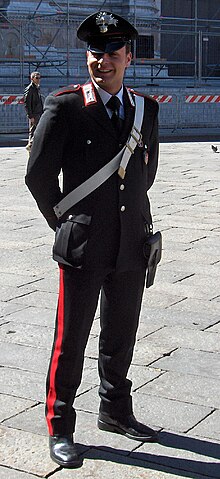
Overview[]
Organisation[]
This section does not cite any sources. (May 2019) |
Law enforcement in Italy is an exclusive function of the State and is organized under the Ministry of the Interior, with provincial division and jurisdiction.[2] The highest office in charge of law enforcement is the ministerial office of "Dipartimento della Pubblica Sicurezza".[3][4]
The Ministry of the Interior is the government department with oversight of all of the national forces. On a local level, the forces are under the provincial authority of the Prefetto, in collaboration with the Questore (the local chief of the Police), that have their offices Prefettura and in every province capital. These offices are in charge of organizing public safety as well as of carrying law-required duties.
This network of hierarchical autonomy efficiently enforces law and order all over the country: balancing equipment, technologies, uniforms, cars, rules and efficacy to all offices, to all cops and, in the end, to all citizens.
The main police force in Italy is Polizia di Stato, or simply Polizia, which is a nationwide, full-powered agency, with different divisions for each specialized area of interest. The Polizia's duties may vary from traffic patrol to investigation, forensic analysis, or riot control. This civilian agency is generally distributed from the medium to large cities up to the province capital, even though exceptions may exist with offices and/or stations in critical towns or in places of interest.
This network of hierarchical autonomy efficiently enforces law and order in all the country, balancing equipment, technologies, uniforms, rules and efficacy to all cops and citizens.
The same duties are carried out also by Arma dei Carabinieri, commonly known as ‘’Carabinieri’’, which are also Military Police for the Italian Armed Forces. The Carabinieri is also in charge of investigation or intervention inside Public Administrations and personal right violations, but mainly because of their history as “defenders of the Constitution" (It is not by chance that the President of Republic safety corps is a special section of Carabinieri called Corazzieri). For this last reason, Carabinieri stations are usually distributed all over the country, with a station approximately in every municipality (or at least every range of 5km), with additional stations in strategical positions along the motorways.[5]
Even though in cases of emergency, both the Polizia di Stato or the Carabinieri may be called upon or may intervene, the strong differences underline the two agencies: the Carabinieri is more an investigation/law breaking control corps, while the Polizia also includes a number of bureaucratic duties around visas, passports, licenses, registration of tourists from hotels, and so on. Moreover in less-populated areas or areas far away from cities (at least in 3700 municipalities) usually the only policing force is the Carabinieri.
Other national forces generally focus on specific and distinguished duties. For example, Guardia di Finanza is the finance and economy police (or roughly Customs, Excise and Fraud squad) and is essentially responsible for dealing with financial crime and smuggling; it has also evolved into Italy's primary agency for suppressing the illegal drug trade. It is a military force which maintains over 600 boats and ships and more than 100 aircraft to serve in its mission of patrolling Italy's territorial waters.
The ‘'Polizia Penitenziaria’’ is the national prison police agency, controlling penitentiaries and taking care of in and out transfers.
There is another type of police in Italy, a police that change in city to city. This police its called Polizia Locale (local police). They are similar to the main police (Polizia di Stato) but this type of police its under the city/municipality jurisdiction, with the main goal of control traffic behaviors, enforcing local laws and regulations, or preventing dangers around the city proprieties. They can also do bureaucratic things, like release concessions regarding residency, shop’s or bar’s use of public sole and so on.
In 2016, the environmental and the forestry police guard called the "Corpo Forestale dello Stato," were absorbed into the Carabinieri, reducing the number of national police forces from five to four.
Powers[]
Italy divides law enforcement into Military and Civil forces, distinguishing each "agency" by duties and jurisdictions. All law enforcement officers are considered "Pubblici Ufficiali" [Public Functionaries] and but not all officers belonging to police forces are "Agenti di Pubblica Sicurezza" [Public Safety officers] as the latter gives the authority to arrest, investigate and patrol in the whole national territory and in all situations.
Specialisation[]
In a different way from other countries (such as the United States), Italy does not have multiple specialized agencies for immigration, drug offenses, patrolling etc, but each “area” is investigated by a dedicated section of each national agency. For example, the Polizia Stradale [highway patrol] is a role within the Polizia, with focus on patrolling the roads and various crimes committed on national and local roads. Therefore, crimes covering multiple "areas" do not need to be covered by multiple agencies.
Border and Maritime patrolling are undertaken by the Guardia di Finanza and Guardia Costiera [Coast Guard]. Officers of the Guardia Costiera, who are members of the Italian Navy, do not have the same range of powers as the Polizia, Carabinieri or Guardia di Finanza, and they should be considered as a "specialty" of the Navy more than "police officers" (they do are Pubblici Ufficiali, but are not Agenti di Pubblica Sicurezza) . Nevertheless, they are in charge of policing and patrolling seaside regulations and laws, both beachside and on water.
Local Level[]
(See below)
On a town level the head of Public Safety is the Mayor. Each town or city has its own police department (Polizia Locale or Polizia Municipale), but they have limited jurisdiction and duties.
Municipal officers work on minor crimes on a local basis, from traffic offenses to small-time drug dealing and illegal camping. Local officers can check driving licenses, enforce municipal laws and ordinances and carry out investigations for robberies and minor offenses, but they cannot form a "riot squad" or interfere with homicide or general investigations by the Polizia di Stato or Carabinieri.
Each Polizia Locale is under the authority of the respective local mayor, but the officers' mandate is valid only during their working hours and within the area their force covers, whereas Carabinieri, Polizia di Stato and Guardia di Finanza are always formally "on duty", wherever they are and regardless of whether they are at work.
Numbers[]
In 2005, the total number of active police officers in all of the agencies was 324,339 in Italy, the highest number in the European Union both overall and per capita, twice the number of agents in the similarly sized United Kingdom.[6]
However, this number includes every officer of the Arma dei Carabinieri, one of the four arms of the Italian Armed Forces, which includes roles which in other countries would not necessarily be considered to be police officers. For example, it has a department akin to workplace inspectors, , one tasked with ensuring proper standards are being met within the food and drink production, , another tasked with the protection of Art and Cultural Patrimony .
Special forces[]
Until 2015 - right during European attacks by Islamic Terrorists - terrorism alarm was very non-existent, so the main policing special forces were few highly specialised Elicopter-supported squads (élite squads or some kind of SWAT) in Rome and Milan.
for Polizia di Stato, G.I.S. for Carabinieri and for Guardia di Finanza.
But with the increase of potential treats the anti-terrorism first response was updated.
Each Province or important city was provided with a medium specialised squad of Carabinieri and one of Polizia to intervene in the shortest time. If necessary they take time waiting for the Élite Squads. They are trained to first respond the medium and medium-high treats, including terrorism, armed bank assaults etc.
These squads are called and for Carabinieri, and for Polizia.
Moreover, Carabinieri has few specialised squads to fight the kidnapping, mafia and drug traffic. This squads are called “Cacciatori” (Hunters) and are present in Sicily, Sardinia, Calabria and Puglia.
Structure[]
This section needs additional citations for verification. (May 2019) |
National police forces[]
Polizia di Stato[]
The Polizia di Stato (State Police) is the civil national police of Italy. Along with patrolling, investigative and law enforcement duties, it patrols the Autostrada (Italy's Express Highway network), and oversees the security of railways, bridges, and waterways.
It is a civilian police force, while the Carabinieri and the Guardia di Finanza are military. While its internal organization and mindset are somewhat military, its personnel is composed of civilians. Its headquarters are in Rome, and there are Regional and Provincial divisions throughout the Italian territory.
Interpol summarizes the primary focus of the Polizia di Stato (Ministry of Interior): "Its responsibilities include investigative and law enforcement duties, and the security of motorway, railway, and waterway networks".[7]
Europol (the EU's law enforcement agency), provides this summary of the force's responsibilities: "protecting the state, safeguarding the rights and freedoms of citizens, supervising the maintenance of public order, maintaining public safety, providing assistance to public entities and private in the event of accidents and disasters as well as the peaceful resolution of disputes between private individuals. It also deals with the training and education, at its facilities, of members of other police bodies... specialty departments include the Traffic, Railway, Communications Police, the Mobile Departments and the Scientific Police. [8]
A program Polizia di Quartiere () has been implemented which increases police presence and deters crime. Pairs of poliziotti (policemen) or carabinieri patrol areas of major cities on foot.
Guardia di Finanza[]
The Guardia di Finanza, (English: Financial Guard) is a military corps under the authority of the Minister of Economy and Finance, with a role as a police force.
The Corps is in charge of financial, economic, judiciary and public safety: tax evasion, financial crimes, smuggling, money laundering, international illegal drug trafficking, illegal immigration, customs and borders checks, copyright violations, anti-Mafia operations, credit card fraud, cybercrime, counterfeiting, terrorist financing, maintaining public order, and safety, political and military defense of the Italian borders.
Interpol summarizes the primary focus Guardia di Finanza (Ministry of Economy and Finance) as "a force with military status and nationwide remit for financial crime investigations; Its responsibilities include investigative and law enforcement duties, and the security of motorway, railway, and waterway networks".[9] Europol (the EU's law enforcement agency), provides this summary: "organized according to a military structure ... the tasks of the Guardia di Finanza consist of the prevention, search and denunciation of evasions and financial violations, in the supervision of the observance of the provisions of political and economic interest and in the surveillance at sea for financial police purposes. ... it also contributes to the maintenance of order and public security, to military defense along national borders for the illegal drug trade ".[10]
The Guardia di Finanza has a strength of around 68,000 soldiers working as agents, NCOs and officers. Its militaries are in service in the Europol, Eurojust and the European Anti-Fraud Office. Its Latin motto since 1933 is Nec recisa recedit (English: Not Even Broken Retreats). The Guardia di Finanza also maintains over 600 boats and ships and more than 100 aircraft to fulfill its mission of patrolling Italy's territorial waters.
During demonstrations and very big events, the Guardia di Finanza is often called on duty as riot police.
Arma dei Carabinieri[]

The Carabinieri is the common name for the Arma dei Carabinieri, a Gendarmerie-like military corps with police duties. They also serve as the military police for the Italian armed forces.
Interpol summarizes this force (part of the Ministry of Defence), with military status, as having "nationwide remit for crime investigations. It also serves as the military police for the Italian armed forces and can be called upon for national defence action."[11] According to Europol (the EU's law enforcement agency), the Carabinieri Corps' military duties include "contributing to national defense, participating in military operations in Italy and abroad, executing military police functions and ensuring the security of Italian diplomatic and consular representations". As a national police force, it "carries out public order and security policing, as well as investigative activities on its own initiative or at the request of the judicial authorities".[12]
The Carabinieri have become a separate armed force (alongside the Army, Navy and Air Force), thus ending their long-standing tradition as the First Corps (Arma) of the Italian Army (Esercito). They are referred to as the Arma or La Benemerita (The Meritorious Corps).
Carabinieri units have been dispatched all over the world in peacekeeping missions, including Bosnia, Kosovo, Afghanistan and Iraq.
In November 2003, twelve Carabinieri of the Multinational Specialized Unit were killed in a suicide bomb attack on their base in Nasiriyah, in southern Iraq. This was Italy's largest military loss in a single action since World War II.
Until 2001,[13] only men were allowed to become part of the Arma (or any military force, for that matter), but military reforms allow women to serve in the Italian military, including Carabinieri.
Having both military police duties and civil police duties, the Arma is usually called on duty as riot police during big events and demonstrations.
According to Europol, this force has "4,672 stations and lieutenancies".[14]
Polizia Penitenziaria[]
The Polizia Penitenziaria (Prison Guards, literally Penitentiary Police, also translated as Prison Police Corps)[15] operates the Italian prison system and handles the transportation of inmates. The training academies for the Polizia Penitenziaria are located in Aversa, Monastir, Cairo Montenotte, Castiglione delle Stiviere, Parma, Portici, Rome, San Pietro Clarenza, Verbania and Sulmona.
Its agents are sometimes called to help the other police forces during major events.
According to Interpol, this force (part of the Ministry of Justice) has a "nationwide remit for prison security, inmate safety and transportation".[16] Europol (the EU's law enforcement agency), provides more specifics as to the corps' responsibilities:[17]
to "ensure order and security inside and outside the buildings, preventing unauthorized entry or exit. In addition, they manage to organize and educate for inmates, and provide transport, escort and guard services for prisoners. The Corps has its own marine service and dog and horse units. Finally, the Penitentiary Police can be deployed to carry out public order and security functions, including public rescue, in cases where they are required to help provide specific civil protection".
Corpo Forestale dello Stato (dissolved)[]
The Corpo Forestale dello Stato (National Forestry Department, now dissolved) was responsible for law enforcement in Italian national parks and forests. Their duties included enforcing poaching laws, safeguarding protected animal species and preventing forest fires. Founded in 1822, the Corpo Forestale dello Stato was a civilian police force specialized on the environmental protection. A recent law reform expanded its duties to food controls.[18] In Italy, it had the responsibility to manage the activities related to the CITES (Convention on International Trade in Endangered Species). The Autonomous Region of Sardinia has its own corp of forestry police.[19]
Corpo Forestale dello Stato was dissolved on December 31, 2016 and all personnel become militarized and absorbed into the Carabinieri's Comando unità per la tutela forestale, ambientale e agroalimentare.
Interforces[]
The Direzione Investigativa Antimafia (or DIA) (Anti-Mafia Investigation Directorate) is a joint organization of Polizia di Stato, Carabinieri, Polizia Penitenziaria and Guardia di Finanza for the fight against organized crime. Founded in 1991, under the authority of the Minister of Interior as the Direzione Nazionale Antimafia (National Anti-Mafia Directorate). Its operations include preemptive investigations, judicial investigations, and international relations, and it investigates characteristics, objectives, and methods of the Mafia as well as their domestic and international contacts. The DIA was to prevent mafiosi from infiltrating the government.[20]
Interpol's National Central Bureau for Italy is part of the International Police Cooperation Service (SCIP), a branch of the Public Security Department (PSD). "SCIP is a multi-agency DPS unit: the Polizia di Stato, Carabinieri and Guardia di Finanza head it, on a rotation basis. Officers representing all police forces staff it", the agency states.[21]
The Direzione Centrale per i Servizi Antidroga (Central Directorate for Anti-Drug Services) is a joint organization of Polizia di Stato, Carabinieri and Guardia di Finanza for the fight against drug trafficking. Founded in 1976 as Direzione Anti Droga (Anti-Drug Directorate), is under the authority of the Criminal police department of the Minister of Interior.
Local police forces[]
Local communities in Italy also have responsibility for local police issues.
They generally fall into either:
- Provinical Police (Polizia Provinciale)
- Local/Municipality Police (Polizia Locale).
Provincial Police[]
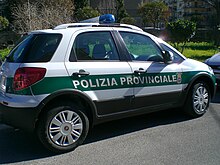
The Polizia Provinciale (Provincial Police) is local police only used in some of the 109 Provinces of Italy.
Their main tasks are to enforce regional and national hunting and fishing laws, but have also expanded in wildlife management and environmental protection. As well as providing a traffic police service and participation in the security services arranged by the authorities.
Municipal and Local Police[]
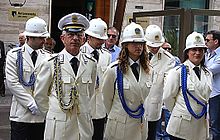
In addition, each comune has its own Polizia Municipale (Municipal Police) whose main duty is to enforce local regulations and traffic laws; it also deals with petty crimes but in larger cities they cooperate with the national police forces to prevent and repress major crimes. Depending on their location they are also called Polizia Municipale, Polizia Locale, Polizia Comunale or Polizia Urbana.

In some regions Polizia Provinciale and Polizia Municipale are grouped together under the name Polizia Locale (Local Police), although they keep their own internal organisation. Small communes can merge their local police forces in a consortium.
Both provincial and municipal forces are reliant on the State Police (Polizia di Stato) for scientific support and other forms of assistance.
Animal Protection[]
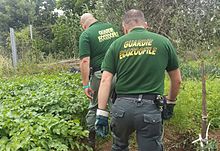
In some areas, there is an animal protection force, or Guardie Zoofile, that rescue animals in distress and protect animals and wildlife.
Agents (as local police officials are generally known in Italy) are volunteer private citizens, who have received some training and have limited powers, with regards to the safety of animals. They do not carry out hunting enforcement.[22][circular reference]
They are part of several different organisations, such as:
- International animal protection organization (OIPA)
- National body for the protection of animals (ENPA)
- Anti-vivisection league
as well as various others.[23][circular reference]
The law (number 189) of 20 July 2004, (relating to the acts of animal abuse), assigns the functions and qualifications of the judicial police to the guards of the protectionist and zoophile associations. This means that they can (and must) continue to take care of the protection of all animals and the protection of livestock - in their capacity as zoophile guards and therefore as public officials of the administrative and judicial police. The guards (recognized by decree issued by the Prefecture) do not have jurisdiction in hunting matters.[24][25]
Agents will check that people are in compliance with all animal-related municipal, regional and national directives and laws and may report them to the Carabinieri, Polizia di Stato, Polizia Locale or Forestry Carabinieri as appropiate.[26]
Some agents have been injured in the line of duty, such as one volunteer who was bit by a dangerous dog, who had been set loose by the owner. In this case, volunteers are public officials' in exercising their role as zoophile guards and are protected as such.[27]
Uniforms and Equipment[]
The Agents generally wear green uniforms, although different to the Guardia di Finanza and Poliziza Locale. As with different local police forces in Italy, they may wear various combinations of:
- Beret or mountain or baseball cap (green or black)[28]
- Shirt or polo shirt (green or black)[29]
- Cargo trousers (green or black)
- Bomber jacket (green or black)
- Boots (black)
- Duty belt, with radio, handcuffs, gloves, etc.[30]
- Some agents do carry firearms (pistols), but some do not, with differing opinion on the subject.[31][32][33][34]
- There is a more formal uniform (as suit similar to GdiF and Polizia uniforms) that some agents wear.
- Motor vehicles used by the Guardie Zoofile generally are marked with such wording and have blue lights and sirens.[35][36]
Historical[]
The Organizzazione di Vigilanza Repressione dell'Antifascismo (or OVRA) (English: Organization for Vigilance in Repression of Anti-Fascism) was a secret police organization in Italy during fascism.
The Polizia dell'Africa Italiana or PAI (Police of Italian Africa) (1936–1944).
The Guardia Nazionale Repubblicana or GNR (National Republic Guard) was a paramilitary force of the Italian Social Republic created by decree on December 8, 1943, replacing the Carabinieri and the MVSN.
Zaptié were locally raised gendarmerie units in the Italian colonies of Tripolitania, Cyrenaica, Colonia Primigenia and Somalia between 1889 and 1942.
Zaptié were used during the period of Trust Territory of Somaliland from 1950 to 1960. Members were sent to Italy to train and after 1960 the merged into the Somali Police Force.
Private Security[]

As with most of Western Europe, private security organisations play a part in security of money, valuables, property and people.
In Italy, a guard, or security officer, is known as a Guardia di Sicurezza. They maybe part of a private security organisation, known as a Servizi di Vigilanza Privata and patrol certain areas or guard buildings.
Services include:
- Armed and unarmed guarding - at banks, shopping centers, courts, museums, construction sites, leisure places, etc[37]
- Armed secure transport/cash-in-transit - of money and valuables[38]
There are certain requirements, similar to police, in order for citizens to become security agents. They must:
- be an Italian citizen or a citizen of a member state of the European Union;
- have reached the age of majority and have fulfilled military service obligations;
- know how to read and write;
- not having been convicted of a crime;
- be a person of good moral conduct;
- be in possession of an identity card;
- be registered in the national social insurance fund and in the workplace accidents fund
- not have been convicted of criminal acivity.[39]
Uniforms and Equipment[]
Some guards are armed (generally with pistols), similar to police, but some are not.[40] These are generally semi-automatic pistols, or revolvers. The licence to carry this must be obtained from the Prefecture by the private security organisation, or the hiring organisation. This is subject to weapon-handling competency checks and health checks.[41]
Uniforms vary greatly from company to company and are often similar, but distinct, to the state and local police forces. Often marked vehicles are used for security work.[42]
Transportation[]
This section needs additional citations for verification. (May 2019) |



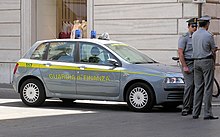


Until recently, all Italian police forces were equipped with Italian-made police cars, with FIAT and Alfa Romeos most common. The most famous of them, the Alfa Romeo Giulia, gave the nicknames of the cars still commonly used today.
A patrol car belonging to Polizia is nicknamed Pantera (Panther), one used by the Carabinieri is nicknamed Gazzella (Gazelle) and every unmarked car is called a Civetta (Owl).
Every force has helicopters, trucks and campers (used as mobile offices, usually in undercover missions). In Venice, which is built across several islands linked by bridges and surrounded by water, public security and fire brigades work with boats.
In 2004, Lamborghini donated two Lamborghini Gallardo police cars to the Polizia di Stato on their 152nd anniversary. On the 31st November 2009 one of these supercars was badly damaged in a collision near the northern Italian town of Cremona where it was on display at a student jobs fair. The car apparently swerved to avoid another vehicle crossing its path and collided with two stationary vehicles; it was repaired in January 2010.
- Arma dei Carabinieri patrol vehicles are very dark blue with a red stripe along the side. Most if not all have white roofs. Their telephone number is also featured - "112" (whilst that of the Polizia di Stato is "113"). Their vehicles have registration plates beginning with "CC".[43] Precedently, Carabinieri cars were dark green: the last green (and the first black) Carabinieri car was the Alfa Romeo Giulia.
- Guardia di Finanza vehicles are dark grey with a thin gold stripe along each side and the words Guardia di Finanza in gold underneath. The vehicle plates begin with the letters “GdiF” in red.[44]
- Polizia di Stato vehicles are light blue with a white stripe along the side and the word POLIZIA in large letters underneath. The license plates start with the word Polizia in red usually followed by a letter and four numbers.[45] Like the Carabinieri vehicles, the cars were precedently green, but before the green colour, the cars were red.
- Polizia Penitenziaria vehicles are dark blue with a light blue stripe along the side and Polizia Penitenziaria in white letters under the stripe. License plates have the entire name POLIZIA PENITENZIARIA on them, followed by three numbers and two letters.[46]
- Corpo Forestale dello Stato vehicles were green with a white stripe and the words CORPO FORESTALE DELLO STATO in white along the side. The vehicle plates began with the letters “CFS” in red.[47] From January 2017 all vehicles have been transferred under the Carabinieri's Comando unità per la tutela forestale, ambientale e agroalimentare. The words "CORPO FORESTALE DELLO STATO" has been replaced with "CARABINIERI", but they still remain green with a white stripe.
- Polizia Provinciale vehicles are white with a green horizontal stripe along the side.
- Polizia Municipale the colours of vehicles depend on regional laws. Usually, the cars are white with blue, green or red stripes and the words "Polizia Municipale" or "Polizia Locale" along the side, in some regions car color can be black or dark grey. License plates have the entire name POLIZIA LOCALE on them and the letter "Y" followed by another letter, three numbers, and two letters.
See also[]
References[]
- ^ https://www.poliziadistato.it/articolo/964-The_Public_Security_System_in_Italy/
- ^ https://www.poliziadistato.it/articolo/960
- ^ https://www.poliziadistato.it/articolo/964-The_Public_Security_System_in_Italy/
- ^ https://www.poliziadistato.it/articolo/959
- ^ http://www.carabinieri.it/arma/curiosita/non-tutti-sanno-che/s/stazioni-carabinieri
- ^ Crime and Criminal Justice - Issue number 19/2008 (KS-SF-08-019) Archived 2011-08-12 at the Wayback Machine
- ^ "Italie". Interpol. 1 March 2016. Retrieved 28 July 2019.
- ^ "Italy". Europol. 7 March 2018. Retrieved 28 July 2019.
- ^ "Italie". Interpol. 1 March 2016. Retrieved 28 July 2019.
- ^ "Italy". Europol. 7 March 2018. Retrieved 28 July 2019.
- ^ "Italie". Interpol. 1 March 2016. Retrieved 28 July 2019.
- ^ "Italy". Europol. 7 March 2018. Retrieved 28 July 2019.
- ^ Camera.it, web: http://www.camera.it/parlam/leggi/deleghe/01215dl.htm
- ^ "Italy". Europol. 7 March 2018. Retrieved 28 July 2019.
- ^ "Italy". Europol. 7 March 2018. Retrieved 28 July 2019.
- ^ "Italie". Interpol. 1 March 2016. Retrieved 28 July 2019.
- ^ "Italy". Europol. 7 March 2018. Retrieved 28 July 2019.
- ^ http://www3.corpoforestale.it/flex/cm/pages/ServeBLOB.php/L/IT/IDPagina/317
- ^ http://www.sardegnaambiente.it/corpoforestale/
- ^ Jamieson, Alison. The Antimafia. Great Britain: Antony Rowe Ltd., 2000. Print
- ^ "Italie". Interpol. 1 March 2016. Retrieved 28 July 2019.
- ^ it:Guardia zoofila
- ^ it:Guardia zoofila
- ^ https://www.earmi.it/diritto/giurisprudenza/Zoofile%20-%20Circolari.pdf
- ^ https://www.armietiro.it/le-guardie-zoofile-non-possono-fare-accertamenti-in-materia-di-caccia-10908
- ^ https://www.ivg.it/2020/04/emergenza-coronavirus-super-lavoro-per-le-guardie-zoofile-savonesi-di-fare-ambiente/
- ^ https://www.lanuovasardegna.it/olbia/cronaca/2014/09/03/news/aizza-il-cane-contro-la-guardia-zoofila-1.9866981
- ^ https://www.ivg.it/2020/04/emergenza-coronavirus-super-lavoro-per-le-guardie-zoofile-savonesi-di-fare-ambiente/
- ^ https://www.ivg.it/2020/04/emergenza-coronavirus-super-lavoro-per-le-guardie-zoofile-savonesi-di-fare-ambiente/
- ^ https://www.sardegnalive.net/news/in-sardegna/34569/cani-rinchiusi-nel-giardino-lager-ristoratore-scoperto-e-denunciato-dalle-guardie-eco-zoofile
- ^ https://www.bighunter.it/Home/Editoriale/Editoriale/tabid/214/newsid732/22831/Default.aspx
- ^ https://lexambiente.it/materie/polizia-giudiziaria/93-giurisprudenza-amministrativa-tar93/13460-polizia-giudiziaria-licenza-di-porto-di-pistola-in-favore-di-guardia-particolare-zoofila-dell%E2%80%99e-n-p-a.html
- ^ https://www.armimagazine.it/porto-darmi-guardie-zoofile-volontarie-dellenpa/
- ^ https://www.lanuovasardegna.it/olbia/cronaca/2014/09/03/news/aizza-il-cane-contro-la-guardia-zoofila-1.9866981
- ^ https://etrurianews.it/wp-content/uploads/2018/11/guardiezzofileenpa4-675x350-1.jpeg
- ^ https://pbs.twimg.com/media/DB_pLr8XYAEsuAS.jpg
- ^ https://www.newmasterpolice.it/tariffe-vigilanza-privata-quali-sono-i-costi/
- ^ https://www.newmasterpolice.it/tariffe-vigilanza-privata-quali-sono-i-costi/
- ^ https://www.newmasterpolice.it/come-diventare-guardia-giurata-requisiti-minimi-e-aggiuntivi/
- ^ https://www.cronachemaceratesi.it/2019/10/14/aggressione-allinps-uomo-bloccato-da-guardia-giurata-cerca-di-prendergli-la-pistola/1312432/
- ^ http://www.prefettura.it/ancona/contenuti/Rilascio_del_porto_di_pistola_per_guardia_giurata_armata-8312.htm
- ^ https://www.guardiedicitta.com/Foto/CategorieSlide/5/servizi_di_vigilanza_armata_guardie_di_citt%C3%A0_20200604165834.146.jpg
- ^ [1]
- ^ [2]
- ^ [3]
- ^ [4]
- ^ [5]
External links[]
| Wikimedia Commons has media related to Italian Police. |
- (in Italian) Polizia di Stato (official website) (English; Francais; Espanol; Deutsch)
- Law enforcement in Italy